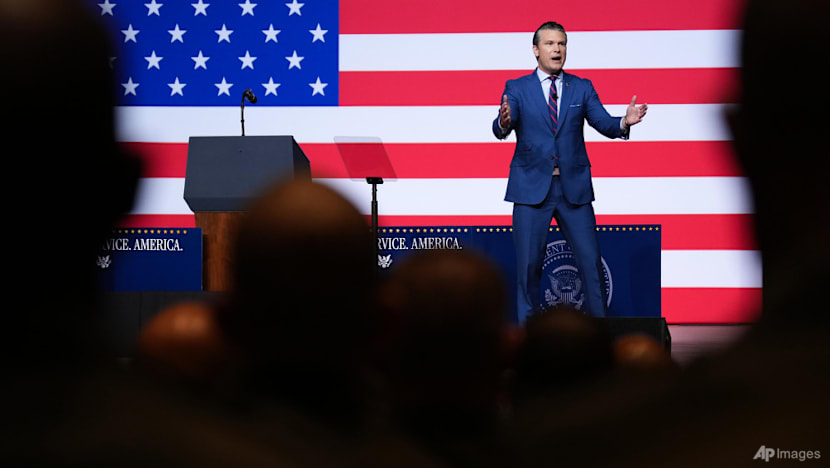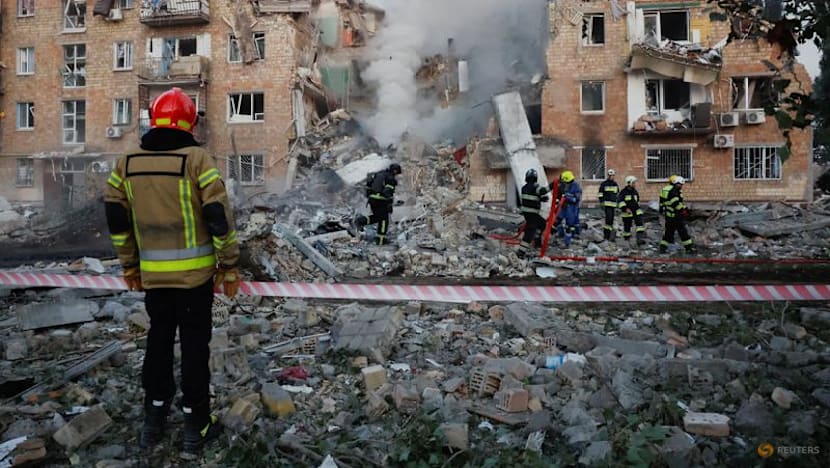Commentary: Soldiers or warriors? What countries need in times of modern warfare
The old-school vision of the military conjured up by US defence chief Pete Hegseth seems at odds with the high-tech modern wars being fought, says Bernard F W Loo from the S Rajaratnam School of International Studies.

Secretary of War Pete Hegseth speaks to senior military leaders at Marine Corps Base Quantico, Sep 30, 2025. (Photo: Andrew Harnik/Pool via AP)

This audio is generated by an AI tool.
SINGAPORE: After summoning hundreds of senior United States military leaders from across the globe to a rare meeting on Sep 30, Secretary of War Pete Hegseth railed against the loss of the “warrior ethos”. He announced new grooming rules and physical fitness requirements at “the highest male standard only”.
The defence chief appeared to harken back to old-school visions of warfighting – athletic soldiers laden with equipment, slogging through dense vegetation and across harsh deserts. It is seemingly at odds with the picture of modern warfare.
As far back as 20 years ago, US-based drone operators were remotely piloting Predator unmanned aerial vehicles (UAV) to target Taliban contingents during the war in Afghanistan. Now, think of Russians and Ukrainians far from the frontlines, launching drone swarms to take out assets and overwhelm air defences. By Ukraine’s account, it has lost more soldiers and vehicles to Russian drones than other traditional weapons of war.
The cutting edge of military technologies has led to increasingly remote applications of deadly force. Against this backdrop, it may be tempting to see the business of warfighting as moving inexorably away from our historical – even cinematic – images of what war looks like.
Is Mr Hegseth out of step with current realities? Is soldiering in the 21st century going to be less physically demanding?

THE EVER-CHANGING CHARACTER OF WAR
That technologies allow military forces to wage war at distance is a fact of life. But they are embraced, not because they make soldiering less physically demanding.
Rather, it is about minimising risk soldiers would otherwise have had to face. US Army General George S Patton famously put it during World War II: A soldier’s job is not to die for his or her country, but to make the adversary die for theirs.
Seen in this light, the Singapore Armed Forces’ announcement in August that all recruits in Basic Military Training will receive six hours of training on the fundamentals of operating and countering drones is strategically necessary.
The 19th-century military theorist Carl von Clausewitz made an important distinction about war: that it has a logic (or nature) and a grammar (or character). It is the character of war that is ever-changing.
How a war is fought is shaped by myriad factors and conditions, such as the state of current military technologies or the specific political purposes of the war. To illustrate, the United States entered World War II with the aim of imposing on Germany and Japan unconditional surrender; compared to the aim five years later, in Korea, of restoring the pre-war division of the Korean peninsula. What had changed was the overarching political context, namely, the emergence of a Cold War between two nuclear powers.
THE EVER-CONSTANT LOGIC OF WAR
But the logic of war is ever-constant: Wars are always fought because one side’s political objectives are seen as antithetical to the other’s political existence.
Technology may enable increasingly remote applications of deadly violence, and thus in principle, might not demand peak physical fitness. But the political purpose of a war will always demand that soldiers be put into harm’s way, whether in the 17th or 21st century.
And if war is a clash of wills, victory comes only when the adversary has lost its will to resist.
During the 1991 Gulf War, several Iraqi soldiers signalled their intention to surrender to a US surveillance drone. More often than not, however, the adversary will have “had enough” once their life is in mortal danger. That requires soldiers to be able to move at pace across contested ground, carrying heavy loads of combat gear, so as to close in on and at least threaten to bring deadly force to the adversary’s position.
As a consequence, fighting wars will continue to demand of soldiers at all levels physical fitness, but also mental resilience.
The first is easy enough to objectively verify, though it is arguable what the “highest male standard only” means and if it will be an appropriate threshold. Armed forces with no combat experience can still put in place fitness protocols that ought to meet the physical rigours of combat.
The second is more challenging to train and defies quantification and objective verification.
Consider the mental determination of Dipprasad Pun, a sergeant of the Royal Gurkha Rifles in the British Army, who single-handedly repelled a Taliban attack from up to 30 fighters, on the night of Sep 17, 2010. The military context encourages and celebrates such acts of resilience, but cannot by itself guarantee that this resilience is universal throughout the culture.
Of course, while physical and mental fitness is necessary to meet the rigours of combat, they are no guarantee of combat success without the intellectual skills of leadership, doctrines and tactics.
DO COUNTRIES NEED SOLDIERS OR WARRIORS?
Eliot Cohen, who had served in the George W Bush administration as senior adviser to Secretary of State Condoleezza Rice, had previously criticised Mr Hegseth’s emphasis on the “warrior ethos”. As he argued: “Warriors are people who exult in killing … and whose behaviour on and off the battlefield often veers into atrocity.”
Soldiers, on the other hand, are “servants of the state … bound by discipline, the rule of law … They serve a common good, and duty, not glory, is their prime motivation.”
Ultimately, there is still a distinction between being a soldier and being a warrior.
Bernard F W Loo is a Senior Fellow at the Institute of Defence and Strategic Studies, the S Rajaratnam School of International Studies, Nanyang Technological University, Singapore.


















